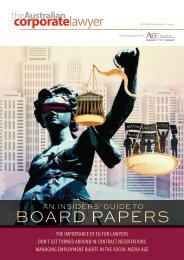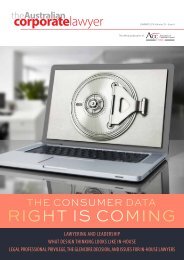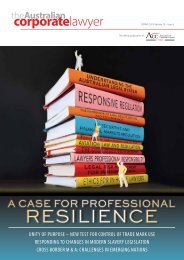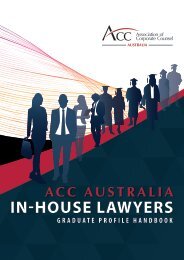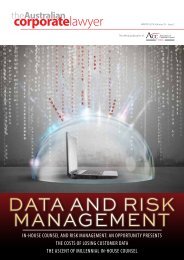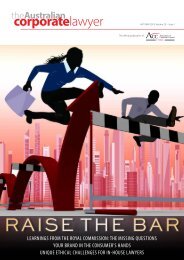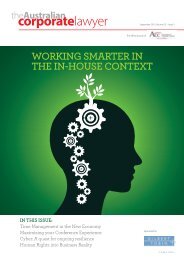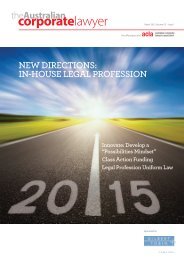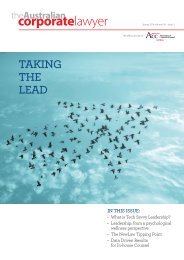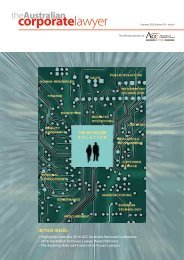Australian Corporate Lawyer - Autumn 2017
Australian Corporate Lawyer is the official publication of the Association of Corporate Counsel (ACC) Australia. The Autumn 2018 issue focuses on 'The Law and Technology' and features a range of articles covering topics including: the future of contracts and; the future of law firms as software companies..
Australian Corporate Lawyer is the official publication of the Association of Corporate Counsel (ACC) Australia. The Autumn 2018 issue focuses on 'The Law and Technology' and features a range of articles covering topics including: the future of contracts and; the future of law firms as software companies..
You also want an ePaper? Increase the reach of your titles
YUMPU automatically turns print PDFs into web optimized ePapers that Google loves.
acla.acc.com<br />
team only access, restricted business use,<br />
or companywide? How does it need to be<br />
accessed, i.e. from phone and smart devices?<br />
• Budget – sometimes it is useful to show the<br />
business cost saving and efficiency gains<br />
which would outweigh the budget required<br />
for the new technology. Most software<br />
requires servicing and maintenance, which<br />
could incur ongoing costs.<br />
• Integration – assessing the ability to<br />
integrate with other systems. Like every<br />
company, our organisation works with<br />
a number of technologies and there is<br />
often resistance to implementing new<br />
technology that has to be supported,<br />
internally and externally. Therefore, the<br />
more these systems can speak to each<br />
other, remove duplications and provide a<br />
smoother user experience the better.<br />
• Implementation – consider implementation<br />
and migration from other systems and<br />
create a project plan.<br />
• Assessment of potential vendors – running<br />
a procurement process could be a good<br />
way of getting a competitive offer and<br />
additional benefits. It is also important to<br />
think of ongoing support from the vendor<br />
and how accessible that would be.<br />
L.O.: For legal-led solutions, we take a<br />
collaborative approach. Being that our<br />
business is technology and especially data<br />
security, we have a firm grasp on the core<br />
drivers for any particular technology and the<br />
associated risks. So once that due diligence<br />
is complete, we let members of the team<br />
assess how useful the technology would be to<br />
them in their practice, then look at the wider<br />
departmental, business and financial benefits.<br />
Of course, internal security and IT stakeholders<br />
will also have particular expertise and can be<br />
an excellent resource to help understand the<br />
“nuts and bolts” of a solution.<br />
5. To what extent is a change in<br />
corporate culture required when<br />
adopting new legal technology?<br />
How have you encouraged your<br />
team and the wider organisation<br />
to embrace the adoption of new<br />
legal technology?<br />
C.S.: I’ve been fortunate enough to work<br />
in innovative and disruptive companies,<br />
which means the conversation with the<br />
wider organisation is often straight-forward.<br />
Encouraging a team approach and having<br />
team members participate in or lead the<br />
process of assessing the team’s challenges and<br />
finding the solutions can help. Taking small<br />
steps rather than trying one “big bang” roll-out<br />
can also be useful.<br />
V.K.: Some of our systems now require clients<br />
to do more via self-service portals, which<br />
helps them help us. For example, we have<br />
implemented an automated system, whereby<br />
a user will answer a list of questions (and<br />
sometimes have choices from a drop down<br />
menu) to determine what contract they need<br />
and what information should be included<br />
in the contract. We are currently working<br />
on further automating this process with<br />
the intent that the system will generate the<br />
agreement and the legal team will only have<br />
to review the end product.<br />
L.O.: Being a technology company, our<br />
corporate culture is one of innovation,<br />
collaboration and best practice. It’s my<br />
expectation and that of my team that we<br />
remain open to new ways of doing things<br />
and always seek to refine and improve our<br />
capabilities (both as practitioners and the tools<br />
we can leverage). We want to deliver the best<br />
possible outcomes for our clients. That means<br />
that we must at all times have a frank and<br />
open flow of information and ideas amongst<br />
the team. Without exception, each team<br />
member absolutely must feel empowered to<br />
raise their voice and suggest improvements.<br />
In my view, this is a fundamental tenet of<br />
effective modern legal practice.<br />
6. What approaches have you<br />
taken to manage the<br />
expectations of board members<br />
or senior executives in your<br />
organisation when adopting<br />
new legal technology?<br />
V.K.: We focus on highlighting the benefits,<br />
efficiencies and advantages. Yet we also take<br />
the time to explain that no system is perfect<br />
and limitations exist in every new technology.<br />
Certain technologies completely change the<br />
way we work, as well as the user experience<br />
and the interface, which means that we<br />
need to factor an adaptation phase and<br />
sometimes resistance from team members<br />
and the business. There is an education and<br />
change management side that needs to be<br />
considered and built into the implementation<br />
process so that people have time to adjust<br />
and embrace the technology. Constructive<br />
feedback is also helpful, but with the<br />
understanding that a solution may not satisfy<br />
everyone’s wish list.<br />
7. How do you measure the<br />
efficiencies brought about from<br />
adopting new technology?<br />
C.S.: This can be challenging, particularly<br />
if there was no measure of efficiency or<br />
output before adopting the new technology.<br />
The solution itself might help measure<br />
improvements over time. A sometimes<br />
overlooked measure of success is stakeholder<br />
feedback, whether informal or more objective<br />
(such as using a “net promoter score” approach<br />
which can be repeated over time).<br />
D.B.: I think a broad measure of time savings<br />
would be a strong contender here. If querying<br />
regulations to find an answer drops from<br />
hours to minutes, then it’s a clear winner. If a<br />
machine learning engine can read a disclosure<br />
document and flag 80% of infringing content<br />
in seconds; it naturally follows that your time<br />
and money can be directed elsewhere.<br />
V.K.: Time, accessibility, transparency,<br />
reporting abilities and budget.<br />
L.O.: Data is critical, but so too is honest user<br />
feedback and personal experience. For making<br />
a proper assessment in relation to efficiency, it<br />
would be imprudent to ignore either measure.<br />
Sometimes the data can obscure or skew<br />
the human element of human-technology<br />
interaction. Likewise, the human element<br />
VOLUME 27, ISSUE 1 – AUTUMN <strong>2017</strong><br />
9



